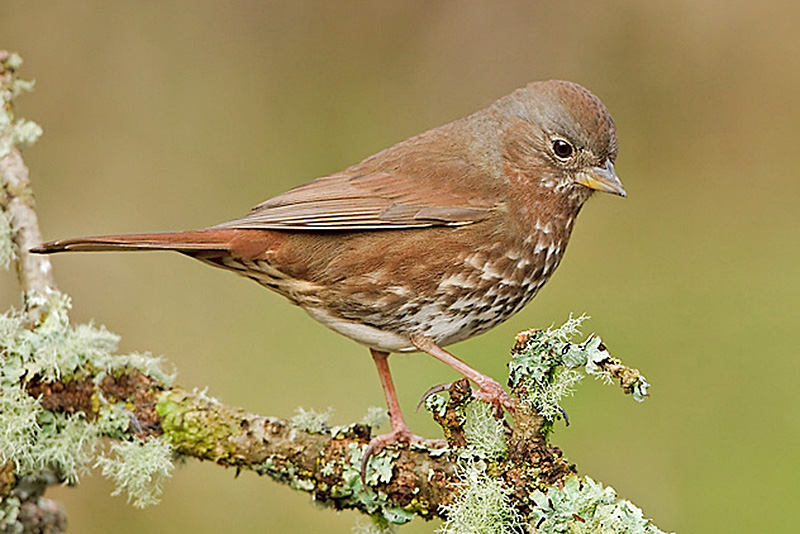Fox Sparrow (Passerella iliaca) is a large brown and gray sparrow with red-brown highlights, a white belly, and thick streaking on its flanks and chest.
If you are birding in a park or wooded area and see a big, streaked sparrow scratching leaves on the ground, you may have found a Fox Sparrow! Occasionally, these fun birds pick up seeds beneath feeders located near brushy vegetation.
Do you think you may have seen one of these neat sparrows? See this article to learn how to recognize and watch Fox Sparrows!
On this page
Identification
The Fox Sparrow is a big sparrow closer in size to a grosbeak than other sparrows. They have conical, yellowish or gray beaks, and usually have gray on their head.
Both sexes of the Fox Sparrow look the same and are 7 inches long, have a 10.5 inch wingspan, and weigh 1.1 ounces. This species looks different depending on where it lives but all populations have a white belly and thick markings on their sides, chest, and on each side of their throat.

Eastern Fox Sparrows are handsome birds with gray and red-brown on their heads and back. They have rich, red-brown on their wings and tail, and red-brown streaking on their chest and sides.
Fox Sparrows from the Pacific Northwest are mostly dark brown and have dark brown mottling on their chest and flanks. Birds from the Rocky Mountains have gray on their head and back, and rich brown on their wings and tail. They also have blackish markings on their chest and flanks.
In and near California, another population of Fox Sparrows look like birds from the Rocky Mountains but have much larger beaks.
Vocalizations
Fox Sparrows sing a cheerful, brief warbling song. It sounds like “chip chip chew zeepuhzipa ZEEP”.
Food
Fox Sparrows feed on a variety of insects, arthropods, and small mollusks. They also eat many berries, some seeds, and occasional plant buds.
During summer, these big sparrows catch lots of beetles, caterpillars, millipedes, spiders, small snails, and other invertebrates that hide in leaf litter and low bushes.
They mostly forage for them by using both feet to scratch and move leaves and other ground debris. When they spot a millipede or other small arthropod, they quickly hop in and snatch it with their beak.
In migration and winter, they still feed on insects and other small creatures but also eat fruit and some seeds. They eat a lot of blackberries, elderberries, and other small fruits that commonly grow in the brushy undergrowth of woodlands. To feed on fruit, Fox Sparrows perch in the bush and pick the berries with their beaks. However, when foraging for seeds, they pick them up from the ground.
Winter is also the best time to see this species at a feeder. Although it probably won’t perch on the feeder like a goldfinch, a Fox Sparrow will pick up seeds underneath the feeder. However, they won’t visit any old feeder. These sparrows much prefer feeders near lots of brushy undergrowth.
Nesting and Eggs
Fox Sparrows arrive back to their breeding grounds in April. They form pairs about a week later and the female starts building her nest a week after that. The female Fox Sparrow is believed to construct her nest by herself and usually finishes it in just two or three days!
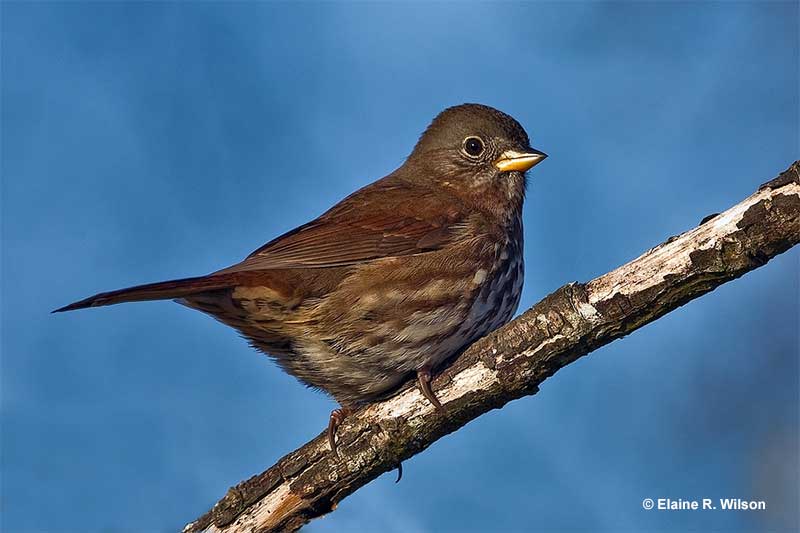
She picks a spot with tree roots or dense vegetation and builds her nest on the ground or in a low tree. To make her cup nest, the mother bird uses shredded bark, moss, grass, and twigs, and lines it with hair, lichen, or other soft materials. It can be pretty small or have a width of one foot!
Once the nest is finished, the female Fox Sparrow lays two to five pale brown eggs covered in red-brown splotches.
They are around .9 inches long, weigh .12 ounces, and hatch after 12 to 14 days. The mother bird does all the incubation duties and is also mostly responsible for feeding the nestlings.
For the next nine to eleven days, she brings her babies lots of caterpillars and insects. After that time, the young birds leave the nest but stay near it for several days. They can be fed by both parents for at least three weeks more.
Current Situation
The Fox Sparrow is a fairly common breeding bird in brushy woodlands and other brushy habitats. It spends the summer in Alaska, northern and western Canada, and the western USA south to California and Colorado.
In migration and winter, we find these birds in woodlands and brushy habitats on the Pacific coast, southern Ontario, and many parts of the eastern and southwestern USA.
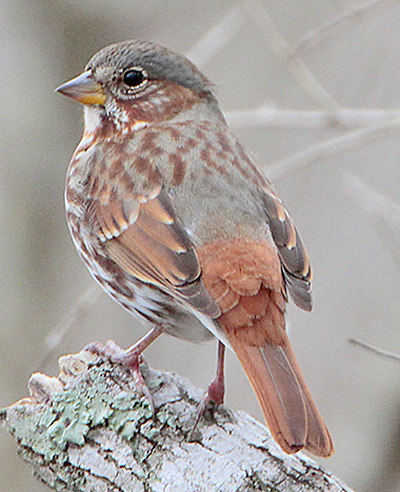
Photograph © Greg Lavaty.
This species is listed as Least Concern in the IUCN Red List and are fairly common birds throughout their range.
Fox Sparrows breed over a very large area and have an estimated population of 35 million. Although there is some concern that logging could affect them in some regions, they are not currently threatened. As long as their remote breeding range is intact and there are plenty of wooded areas in their wintering distribution, Fox Sparrows should continue to be common birds.
Facts
- The “fox” in this bird’s name refers to the “fox-colored” red-brown plumage shown by birds in the eastern part of their range. This subspecies is sometimes known as the “Red Fox Sparrow”.
- If you see a Fox Sparrow on its breeding grounds that looks like it has a broken wing, you can bet it has a nest nearby! When nesting, females distract possible predators with loud, sharp calls and pretending to be injured.
- Fox Sparrows don’t like to come into the open. However, during migration and winter, there’s a good trick for finding them. In woodlands, listen for the sound of rustling leaves. If you see some leaves being moved and tossed on the forest floor, look closer; there might be a Fox Sparrow kicking them around.
- Some international bird lists separate the Fox Sparrow into four separate species. However, despite their distinct plumages, North American lists still consider them related enough to all be the same species.
Similar Species
The Fox Sparrow is one of the more distinctive sparrow species. However, it does have some similarities to a few other sparrows.
Song Sparrow
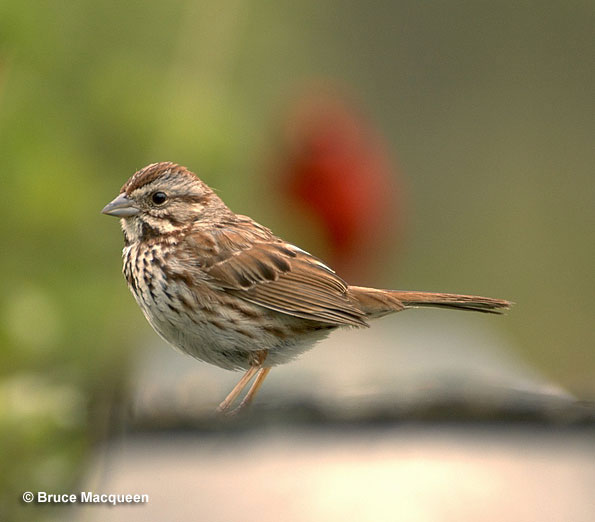
The Song Sparrow is sometimes confused with the Fox Sparrow. It can also have some red-brown in its plumage and has a similar streaked pattern on its underparts. However, the Fox Sparrow is larger, has a yellowish beak, and more red-brown on its back and head. The Fox Sparrow also lacks the buff moustache mark shown by most Song Sparrows.
Lincoln’s Sparrow
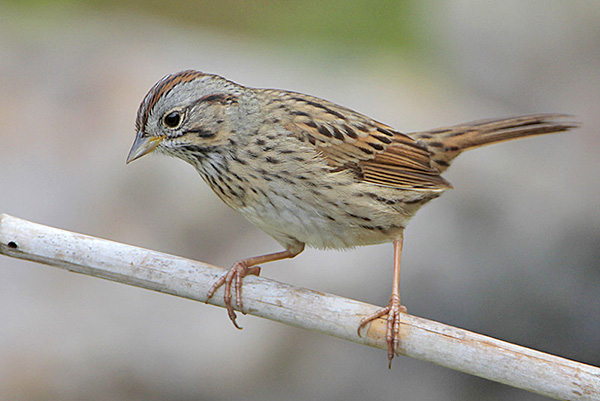
Photograph © Greg Lavaty.
In migration, the small, streaked Lincoln’s Sparrow can be seen in the same wooded undergrowth as the Fox Sparrow. However, it is much smaller, doesn’t have as much red-brown in its plumage, and has a bush wash on its chest.
Swamp Sparrow
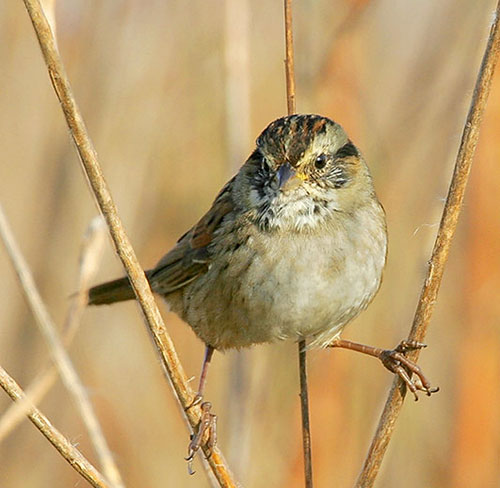
The Swamp Sparrow prefers wetlands and has a lot of red-brown in its plumage. It can also forage in some of the same areas as the Fox Sparrow. However, it is smaller, and does not have heavily streaked underparts.
Frequently Asked Questions
Why is it called a Fox Sparrow?
It is called a Fox Sparrow because some Fox Sparrows have a lot of rusty, red-brown coloring in their plumage.
What does a Fox Sparrow look like?
A Fox Sparrow looks like a large sparrow with a yellowish beak, and heavy streaking on its underparts. They can be mostly dark brown, be red-brown and gray, or have gray heads and backs, and brown wings and tails.
What is the difference between a Fox Sparrow and a Song Sparrow?
The difference between a Fox Sparrow and a Song Sparrow is that the Fox Sparrow is larger and has a pale beak. It also has either a gray head, dark brown head, or is mostly red-brown and gray.
Where do Fox Sparrows migrate?
Fox Sparrows migrate to wooded habitats in southern Ontario, much of the eastern USA, the Pacific coast, and parts of the southwestern USA.
What does the song of a Fox Sparrow sound like?
The song of a Fox Sparrow sounds like a brief series of whistling and trilled notes.

